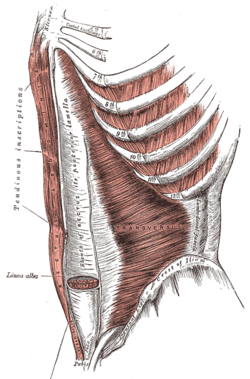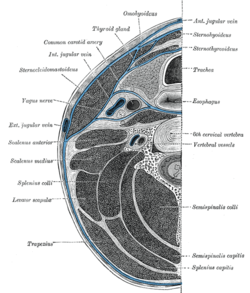Levator muscle
Levator Muscle

The Levator Muscle is a group of muscles found in the human body that are responsible for lifting or elevating certain structures. The term "levator" is derived from the Latin word "levare", which means "to lift". There are several types of levator muscles, including the Levator ani, Levator scapulae, and Levator palpebrae superioris.
Structure[edit]
The levator muscles are skeletal muscles that are attached to bones or other muscles by tendons. They are innervated by the nervous system and receive signals to contract or relax, which results in the lifting or lowering of the structure they are attached to.
Levator Ani[edit]

The levator ani is a broad, thin muscle located on the side of the pelvis. It is part of the pelvic floor and plays a crucial role in maintaining continence.
Levator Scapulae[edit]

The levator scapulae is a muscle located at the back and side of the neck, and its primary function is to lift the scapula.
Levator Palpebrae Superioris[edit]

The levator palpebrae superioris is the muscle in the upper eyelid that lifts the eyelid.
Function[edit]
The levator muscles play a crucial role in various bodily functions, including breathing, swallowing, and maintaining posture. They also contribute to facial expressions and eye movements.
Clinical Significance[edit]
Dysfunction or damage to the levator muscles can lead to a variety of medical conditions, such as ptosis (drooping of the eyelid), pelvic organ prolapse, and neck pain.
See Also[edit]
References[edit]
<references group="" responsive="1"></references>
Ad. Transform your life with W8MD's Budget GLP-1 injections from $75


W8MD offers a medical weight loss program to lose weight in Philadelphia. Our physician-supervised medical weight loss provides:
- Weight loss injections in NYC (generic and brand names):
- Zepbound / Mounjaro, Wegovy / Ozempic, Saxenda
- Most insurances accepted or discounted self-pay rates. We will obtain insurance prior authorizations if needed.
- Generic GLP1 weight loss injections from $75 for the starting dose.
- Also offer prescription weight loss medications including Phentermine, Qsymia, Diethylpropion, Contrave etc.
NYC weight loss doctor appointmentsNYC weight loss doctor appointments
Start your NYC weight loss journey today at our NYC medical weight loss and Philadelphia medical weight loss clinics.
- Call 718-946-5500 to lose weight in NYC or for medical weight loss in Philadelphia 215-676-2334.
- Tags:NYC medical weight loss, Philadelphia lose weight Zepbound NYC, Budget GLP1 weight loss injections, Wegovy Philadelphia, Wegovy NYC, Philadelphia medical weight loss, Brookly weight loss and Wegovy NYC
|
WikiMD's Wellness Encyclopedia |
| Let Food Be Thy Medicine Medicine Thy Food - Hippocrates |
Medical Disclaimer: WikiMD is not a substitute for professional medical advice. The information on WikiMD is provided as an information resource only, may be incorrect, outdated or misleading, and is not to be used or relied on for any diagnostic or treatment purposes. Please consult your health care provider before making any healthcare decisions or for guidance about a specific medical condition. WikiMD expressly disclaims responsibility, and shall have no liability, for any damages, loss, injury, or liability whatsoever suffered as a result of your reliance on the information contained in this site. By visiting this site you agree to the foregoing terms and conditions, which may from time to time be changed or supplemented by WikiMD. If you do not agree to the foregoing terms and conditions, you should not enter or use this site. See full disclaimer.
Credits:Most images are courtesy of Wikimedia commons, and templates, categories Wikipedia, licensed under CC BY SA or similar.
Translate this page: - East Asian
中文,
日本,
한국어,
South Asian
हिन्दी,
தமிழ்,
తెలుగు,
Urdu,
ಕನ್ನಡ,
Southeast Asian
Indonesian,
Vietnamese,
Thai,
မြန်မာဘာသာ,
বাংলা
European
español,
Deutsch,
français,
Greek,
português do Brasil,
polski,
română,
русский,
Nederlands,
norsk,
svenska,
suomi,
Italian
Middle Eastern & African
عربى,
Turkish,
Persian,
Hebrew,
Afrikaans,
isiZulu,
Kiswahili,
Other
Bulgarian,
Hungarian,
Czech,
Swedish,
മലയാളം,
मराठी,
ਪੰਜਾਬੀ,
ગુજરાતી,
Portuguese,
Ukrainian
